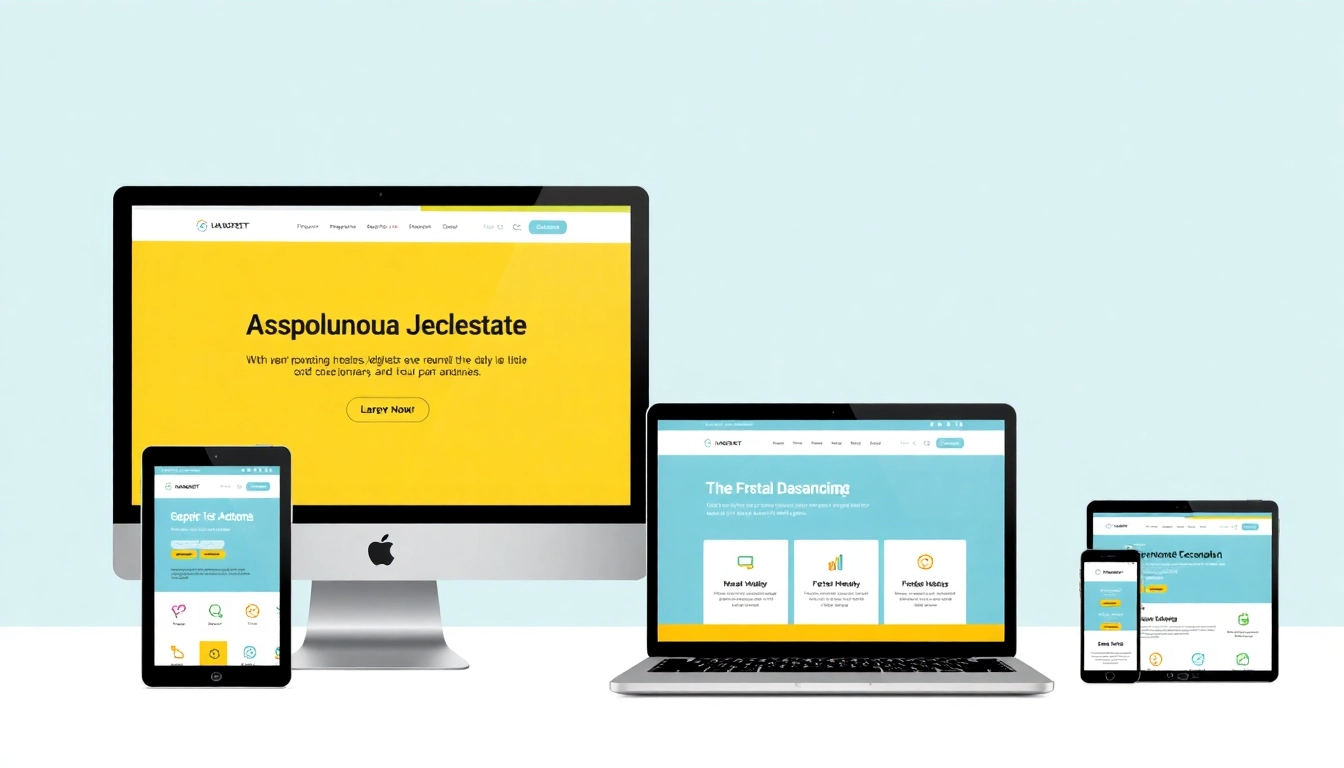Understanding the Market for Budget Webpages
In today’s digital landscape, establishing a strong online presence is essential for businesses of all sizes. For entrepreneurs and small companies, investing in a professional website can seem daunting, especially when working with limited budgets. This has paved the way for a thriving market of paginas web baratas, or affordable websites, tailored to meet the demands of cost-conscious clients seeking effective online solutions without sacrificing quality. Understanding current trends in budget web design reveals an increasing emphasis on simplicity, responsiveness, and SEO compatibility, all while maintaining affordability.
The competitive landscape sees a variety of service providers offering web design packages at accessible prices, ranging from minimalist one-page sites to full-scale small business portals. Market insights demonstrate a shift toward leveraging templated designs, user-friendly platforms like WordPress, Wix, or Shopify, and emphasizing mobile compatibility as a standard feature. This approach not only reduces costs but also accelerates development times, enabling faster deployment and quicker returns on investment. The key features of these affordable webpages often include responsive design, basic SEO setup, and content management capabilities, ensuring clients can grow their online presence organically over time.
Common Challenges When Creating Low-Cost Websites
Despite the advantages, developing paginas web baratas is not without challenges. These include limitations in customization, potential compromises in design uniqueness, and concerns over scalability and security. Many low-cost solutions rely heavily on pre-made templates, which can make sites look generic if not properly customized. Additionally, some providers may offer limited functionalities or overlook essential SEO practices, affecting visibility in search engine rankings. To overcome these challenges, it’s vital to choose reputable providers who incorporate scalable tech stacks, ensure mobile responsiveness, and prioritize ongoing support and updates.
Planning Your Cost-Effective Web Presence
Defining Your Business Goals and Target Audience
Before initiating any web project, clearly defining your business objectives and understanding your target market is crucial. Are you aiming to generate leads, showcase products, or build a community? Knowing this shapes the website’s structure, content, and functionality. For instance, a local restaurant might prioritize a menu and reservation system, while a portfolio artist may focus on visual galleries. Setting specific goals ensures that you allocate resources efficiently, avoid unnecessary features, and streamline your design process, ultimately reducing costs.
Choosing the Right Platform for Cost Efficiency
Selecting an appropriate platform is the backbone of an affordable yet professional website. Platforms like WordPress, Wix, and Weebly offer free or inexpensive templates that can be customized easily, making them ideal for small budgets. WordPress, with its extensive plugin ecosystem, allows for scalable solutions as your needs grow. Wix and Shopify provide intuitive drag-and-drop interfaces, enabling DIY development that minimizes expenses. When making this choice, consider factors such as ease of use, scalability, SEO features, and available integrations to ensure long-term viability without substantial additional investment.
Setting a Realistic Budget and Timeline
Establishing a clear budget and timeline from the outset prevents scope creep and financial overruns. For example, a basic one-page website can start at around €150, with additional costs for premium template customization or ongoing hosting. Setting a deployment goal of 4-6 weeks gives manageable milestones for content creation, design revisions, and testing. Remember to include contingencies for unforeseen challenges, and prioritize core functionalities first, adding advanced features only as your budget permits. Using cost-effective tools and templates accelerates development and ensures you meet deadlines without unnecessary expenditures.
Designing a Professional and Responsive Web Page
Utilizing Templates and Personalization
Templates are indispensable for budget-friendly web design, dramatically reducing development costs. They provide a professional look with pre-coded layouts, fonts, and visuals. Customization through editing tools allows you to align themes with your branding, colors, and content. For example, a small business can select a sleek, minimalist template and insert their logo, contact details, and services, creating a unique yet economical website. Ensuring that templates are mobile-responsive is critical, offering a seamless experience across devices and enhancing user engagement.
Ensuring Mobile Compatibility and Accessibility
Given that over 60% of web traffic originates from mobile devices, responsiveness isn’t optional—it’s essential. Responsive design ensures that site elements adapt fluidly to different screen sizes, improving usability and retention. Accessibility considerations, such as alt text for images, keyboard navigation, and color contrast, are equally important to reach wider audiences and comply with legal standards. Using built-in responsive templates and testing across multiple devices helps maintain high quality without additional costs.
Incorporating Visual Elements and Content
Effective visuals and compelling content drive visitor interest and aid in conversions. Free or affordable stock images, combined with consistent branding and minimalistic layouts, create an attractive aesthetic without overspending. Content should be clear, relevant, and optimized for keywords related to your niche to improve SEO. Incorporate calls-to-action, testimonials, and bullet points to make the site engaging. Remember, simplicity often enhances professionalism; resist the temptation to overload pages with unnecessary graphics or lengthy text, which can detract and increase load times.
Optimizing SEO and User Engagement on a Budget
Implementing Basic SEO Strategies
SEO is fundamental to attract organic traffic, even on tight budgets. Focus on optimizing meta titles and descriptions, using relevant keywords naturally within content, and ensuring fast load speeds. Many free tools, such as Google Search Console and Yoast SEO, guide beginners toward best practices. Also, crafting descriptive URLs, adding alt text to images, and establishing a logical site hierarchy enhance visibility. Remember, SEO is an ongoing process; regular content updates and backlink building are key to sustained rankings.
Creating High-Quality, Relevant Content
Content is king in digital marketing. On a budget, prioritize creating valuable content that addresses your audience’s needs, questions, and pain points. Blog posts, FAQs, and case studies not only add fresh keywords but also position your site as an authoritative resource. Use clear headers, concise language, and multimedia elements to make content engaging. Consistency is vital; regularly updating your website encourages repeat visits and improves search ranking.
Tracking Performance and Making Improvements
Using analytics tools like Google Analytics helps you monitor visitor behavior, identify bottlenecks, and refine your strategy. Track key metrics such as bounce rate, session duration, and conversions. Based on data insights, optimize underperforming pages, adjust content, or improve loading times. Data-driven decisions are crucial to ensure your investment into a low-cost website yields measurable results and continually enhances user experience and SEO performance.
Future-Proofing Your Cost-Effective Website
Adding Functionality as Your Business Grows
Start small with essential features like contact forms, basic galleries, or service descriptions. As your revenue increases, progressively add functionalities such as e-commerce capabilities, booking systems, or live chat support. Platforms like WordPress and Wix enable scalable expansions through plugins and apps, allowing your website to evolve without significant reworks or costs.
Maintaining Security and Updates
Security is vital to protect your data and maintain customer trust. Regularly update plugins, themes, and platform cores to patch vulnerabilities. Enable SSL certificates to encrypt data transmission, which is often included free in hosting packages. Routine backups prevent data loss, and using reputable hosting providers reduces risks and ensures compliance with data privacy standards. These proactive measures ensure your website remains reliable, secure, and compliant over time, even on a budget.
Utilizing Cost-Effective Marketing Tactics
Organic marketing strategies such as content marketing, social media engagement, and local SEO are inexpensive yet effective. Consistently posting valuable blog articles, leveraging free social platforms, and ensuring your business appears on local directories can significantly boost visibility without heavy ad spend. Email marketing campaigns, managed via affordable tools like Mailchimp, foster customer loyalty and drive repeated traffic. Combining these tactics maximizes your ROI and sustains your digital growth at minimal expense.



